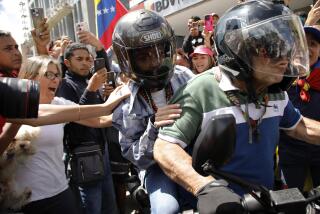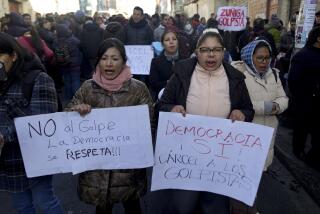Argentine Rebel Units Surrender : Regime Denies Any Concessions in 3-Day Insurrection
- Share via
BUENOS AIRES — Surrounded by tanks poised to attack, hundreds of mutinous Argentine soldiers gave up their three-day insurrection Sunday without winning a single concession, the government said.
Officials vehemently denied an array of reports that the right-wing leader of the uprising, Col. Mohamed Ali Seineldin, had surrendered in return for the resignation of the army’s top commander, Gen. Jose Dante Caridi.
By midnight, Seineldin apparently remained with his followers inside the Villa Martelli military base, his stronghold on the northern edge of this capital. The government said the soldiers were handing in their arms and removing explosives they had planted. The government said Seineldin would be taken into custody but did not say when.
The standoff ended after a day of fierce skirmishing outside the main gate of the rebel camp, a munitions and logistical base.
Angry Demonstrators
Hundreds of angry, pro-government demonstrators attacked the mutineers with rocks and firebombs in repeated forays while loyalist troops waited a few hundred yards away.
Unconfirmed news reports said two protesters were killed and about 20 wounded by rubber bullets and what appeared to be live ammunition fired by the rebels guarding the beige stone arch at the entrance to the base. Several police officers also were wounded.
Ducking tear-gas barrages, the demonstrators shouted obscenities at the rebels, lit grass fires inside the perimeter and shouted, “Let the government give us arms!”
There was no explanation why the authorities permitted the protesters to remain in a grassy field facing the gate, between the rebels and the tanks, armored personnel carriers and troop trucks of the loyalist forces.
100-Degree Heat
Just before 7 p.m., on a late spring day with searing temperatures near 100 degrees, the loyalist units surrounding the Villa Martelli base suddenly withdrew, and word spread that the rebels had surrendered.
President Raul Alfonsin, in a brief statement to the nation, said “there were no concessions of any kind.” He said that Caridi still has his full support and confidence.
The president said the overwhelming loyalty of the armed forces and the preponderance of strength deployed against the dissidents persuaded the latter to lay down arms without a fight.
“Now let us go on with our work . . . convinced that the Argentine nation will continue building its future in democracy and peace,” Alfonsin said.
Speculation on Deal
Still, speculation persisted that the rebels had obtained some kind of deal to end the third military rebellion against Alfonsin’s government since April, 1987. It also became clear during the day that a number of army units, if not actively joining the insurrection, had declined to join it.
All three revolts focused on demands for an amnesty for officers convicted of human rights violations during the military dictatorship from 1976 to 1983, during which at least 9,000 people “disappeared,” a euphemism for the killing of government foes.
The army regards that campaign with pride, saying the nation was saved from radical leftist subversion, and many officers remain embittered that five former military junta members are serving life prison terms for rights offenses. Furthermore, officers have complained about the conviction of senior colleagues, including former President Leopoldo F. Galtieri, for the armed forces’ humiliating defeat in the Falklands War with Britain in 1982.
That debacle cleared the way for a return to democratic rule and Alfonsin’s election victory in 1983, with a pledge to put human rights offenders on trial. The two previous revolts forced the president to agree to curtail prosecutions to a handful of senior officers, but even those limited cases still rankle.
Armed Forces Cuts
Drastic cuts in the armed forces’ budget and troop strength--both are now about half their 1983 levels--also have angered the military, which has staged six coups d’etat since 1930.
Seineldin, a 54-year-old Falklands War veteran, had declared that he never sought to foment a coup, but to resolve problems and injustices affecting the military. Alfonsin also agreed that the revolt did not jeopardize Argentina’s restored democracy.
However, Seineldin, who was Argentina’s military attache in Panama until two weeks ago, was known to be dissatisfied with Caridi for purging the officer corps of those allied to Lt. Col. Aldo Rico, who led the previous two revolts. Seineldin recently was passed over for promotion to general.
The rebels’ strength was unclear. Seineldin had claimed to have 400 followers on Friday when he seized the infantry school at Campo de Mayo near here, the largest military base in the country. He broke away from there Saturday, unmolested by loyalist troops surrounding the base, and moved to the Villa Martelli base closer to the downtown area, where the 101st Arsenal Battalion and the 10th Logistical Battalion joined him.
‘Demands Shared’
A mechanized regiment in rural Mercedes declared its support for the insurrection Sunday, and the commandant of the 4th Air Transport Brigade, Gen. Adolfo Etcheun, said that while he didn’t support the uprising, “the entire army shares the demands of Seineldin.”
Several senior politicians openly characterized the revolt as a coup attempt and the most serious challenge to government authority since Alfonsin took office, and they called Saturday for an outpouring of public support for the civilian government. Tens of thousands of people filled public plazas in cities around the country for vigils that lasted through the night, ending only when word came that the crisis had passed.
In front of the Congress building in Buenos Aires, several thousand people, mainly young and predominantly from leftist political parties, danced and sang through the day despite the brutal heat. Three fire trucks doused them with water to cool them down. One banner proclaimed: “Alfonsin, We Are Behind You.”
If the army’s support was in question, there was no doubt about the determination of the neighbors and young people who gathered at the base entrance, itching for a chance to challenge the mutineers.
Children Near Tanks
Early in the day, the scene was relatively tranquil. But with the arrival of about 30 tanks from loyal units, the tension increased. The tanks moved into the narrow streets of a middle-class residential area facing the base, chewing up the pavement and flattening grass and trees in a nearby park. Children played on swings and slides nearby.
Police and soldiers made a half-hearted attempt to evacuate civilians and residents from the houses, but did not try to dislodge those already inside the perimeter, including dozens of reporters in the field facing the gate.
Their expectations heightened by the arrival of the loyalist armor, the demonstrators began charging the gate and hurling rocks. The rebels responded with tear-gas canisters, then rubber bullets. The protesters advanced at one point behind a metal sign ripped from the ground that declared, “Military Area: Dim Your Lights. Follow Orders.”
By late afternoon, the conflict worsened and the rebels were discharging dozens of rounds toward the protesters. One demonstrator fell with what appeared a bullet wound in his neck, and news reports said that an 18-year-old had died of such a wound.
Agitated Crowd
The withdrawal of loyalist tanks, before word circulated of the surrender, further agitated the crowd. Some rocks were thrown, and gunshots were heard. There were conflicting versions on whether gunfire from loyalist troops and police, who later arrived to disperse the crowds, had caused some of the casualties, or whether all were caused by the rebels.
A local news agency report said some cars speeding from the base, apparently carrying mutinous troops, also had fired on the crowd and caused casualties near the tumultuous conclusion to the day.
More to Read
Sign up for Essential California
The most important California stories and recommendations in your inbox every morning.
You may occasionally receive promotional content from the Los Angeles Times.












